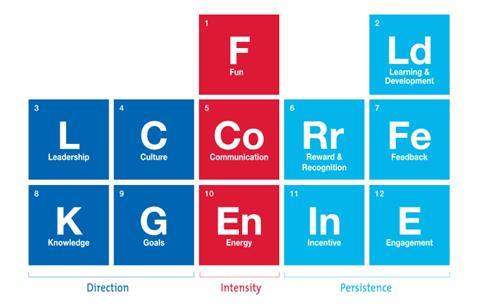
It is widely accepted that a successful organisation is one that invests in its employees and uses a range of motivational tools to increase production and profit. However, mastering the art of embedding a culture of motivation across the whole organisation can be challenging.
So, why is it so hard to keep people motivated and how can science help us achieve optimum levels of motivation in the corporate arena?
Experts all agree, there are three critical dimensions that sustain motivation and influence behaviour. These are: direction, intensity and persistence. These three must be embraced to ensure that a business is ready to foster the values of motivation across the whole organisation.
Direction: The starting point for every businessAs tempting as it may be to start offering rewards and incentives to employees as soon as possible, it really does pay to do some groundwork first.
There are four key elements of direction:
LeadershipTo truly motivate a workforce, the leadership team needs to live and breathe the organisation’s values, it needs to act as role models to others and be the embodiment of what the organisation wants to achieve. It needs to act with transparency, objectivity, and fairness always.
CultureThe culture of motivation needs to be one that people naturally want to be a part of. It needs to be pervasive, provide a sense of purpose and reward great performance to create a workforce that instinctively wants to work harder.
KnowledgeEquip the leadership team with the knowledge it needs to be confident about what is expected of it, with clear expectations and open channels of communication allowing it to ask for clarification when needed.
GoalsGoals need to be timely, flexible, and individualised. Employees need to see how their own goals fit into the over-arching goals of the organisation, as without context, their goals run the risk of feeling inconsequential.
Intensity: ramp it upOnce the foundations for motivation have been laid, it is time to start the real fun and amplify the intensity, creating a fun, energised environment where employees are happy and engaged.
FunWith the absence of fun, it is all too easy for workers to become demotivated, unhappy and unfocused. When employers make having fun a priority, it creates happier employees who look forward to coming into work.
CommunicationEffective communication is the most powerful management tool in employers’ arsenal. Without it, their most valued people can become isolated. Senior management must take the time to explain the organisation’s visions, intentions, direction and goals.
EnergyEnergy is infectious. In terms of motivation, this means that employers need to be aware of how they spend their energy in the workplace, and how much energy they put into any motivational tools used.
Persistence is the key to successHaving laid the foundations to an employee motivation programme, and then injected it with some energy, the next step is to ensure its longevity. This can be achieved by following these five key components:
Learning and developmentThe advantages of investing in a comprehensive learning and development programme are far-reaching, both for individuals and for the organisation itself. Once employees know that they are worthy of investment, they will feel energised, focused, and driven, and employers will soon find that their investment pays for itself.
Reward and recognitionThe right rewards and incentives incorporated into an engaging recognition programme will keep employees motivated, build positive associations and have a long-term effect on motivation.
FeedbackFeedback is essential to engage employees, propose new ways of getting things done and highlight areas of excellence and areas to be improved.
Feedback needs to be regular and mostly positive. Instead of leaving it to the annual review, find ways to make it a natural and normal part of interacting with teams.
IncentiveIncentive is essential to encourage participation and collaboration. Whatever it is that employers choose as the focus of their incentive scheme, make sure that it reflects the organisation’s values and that it plays a part in helping to cement them.
EngagementEmployers can invest all the money they like and offer the most amazing rewards, but this is all pointless if no one engages. For a motivational programme to succeed it needs to: Be well-communicated by confident, inspiring leaders; become a part of the culture; be fun and energetic; offer a wide range of rewards; and include a comprehensive staff development programme
If all these elements are in place a motivation strategy will become something that not only ensures that employers retain their best staff, but will also attract the highest calibre of candidates when it comes to filling future positions.
James Kelly is director at Red Letter Days Motivates

















